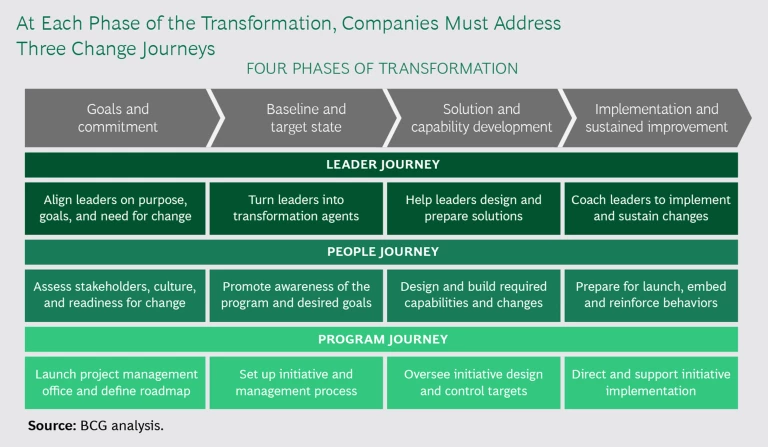When a company launches a large-scale transformation, leaders can feel as though they’re flying blind. Are their teams ready for a transformation? Are the right elements for success in place? How should they define change readiness, and what specific actions will deliver the greatest business value?
Understanding an organization’s readiness for change is the fundamental building block for all successful transformations. companies must systematically assess the preparedness of leaders, employees, and the transformation program. Complicating things further, the definition of readiness will vary for each phase of the transformation: the preparation necessary for the goals and commitment phase is different than that for implementation, for example.
With so many moving parts, it’s no wonder that a business transformation is a complex and often chaotic endeavor. Companies need to understand the areas where they are fully prepared, partially prepared, or flat-out unprepared. For that, it’s essential to conduct a systematic assessment of change readiness backed by strong analytics.
And it is worth the effort. The transformation success rate for companies that effectively manage the leader, employee, and program journeys is nearly twice that of their peers. Given that 75% of transformations fail to deliver envisioned results, companies have much to gain by flipping the odds in their favor.
A New Approach to Change Readiness
When we discuss change readiness with executives, the response is almost always anecdotal or intuitive. We hear such generic things as, “Our leaders aren’t very experienced with change management,” or “Our employees may be resistant to change,” or “Our communication could be better.”
Chief transformation officers (CTOs) and other leaders need to understand how their change management capabilities compare with those of their peers in order to determine where to focus their efforts to deliver a successful transformation. With a data-driven, action-oriented approach to change readiness, transformation leaders can move beyond anecdotal evidence and identify the specific challenges of the upcoming change. This enables them to take the right actions at the right time.
With a data-driven, action-oriented approach to change readiness, leaders can move beyond anecdotal evidence and identify the specific challenges ahead.
Prepare for change at three levels. A readiness assessment should serve as the foundation to address key questions: How will we prepare leaders to drive change? How will we engage and empower employees? How will we manage the program to maximize impact? It’s not enough to diagnose problems; companies need a clear path forward to resolve problems.
What’s more, companies need to avoid wasting precious time and energy on actions that create minimal value. Leaders must be prepared to say no to suggestions that aren’t backed by data. Focusing on the wrong things diverts key resources from high-impact, mission-critical initiatives, ultimately weakening the overall effort.
To transform successfully, companies must prepare for change and take the right actions at three levels. (See the exhibit.)
- Leader. Executives and managers need to be activated, aligned, energized, and equipped to inspire and drive the change.
- People. Employees need to be engaged and empowered in real time through transparent multiway communications.
- Program. New governance and adaptive end-to-end program management practices need to be in place to ensure rapid change.
Do the right things at the right time. Transformations typically follow four phases:
- Goals and Commitment. Executives create alignment and transparency around the vision and goals.
- Baseline and Target. After establishing a clear picture of the organization today and what it will become in the future, the broader leadership team makes the case for change to employees and other stakeholders.
- Solution and Capability Development. Leaders create detailed business initiatives (introducing new processes, systems, and operating models), pinpoint the changes that need to be made across the business, and identify new capabilities that will be required to implement successfully.
- Implementation and Sustained Improvement. Frontline leaders and teams execute solutions and promote new behaviors to support the right outcomes.
A change readiness assessment should always take into account what is needed at each distinct phase. The type of transformation matters as well, whether it’s a cost reduction effort, a digital transformation, or an agile transformation, for example. Very often, companies are undertaking more than one type of transformation at the same time.
A change readiness assessment should always take into account what is needed at each distinct phase of the transformation.
What’s more, the actions that need to be taken—and the readiness of the leaders, employees, and programs—will vary widely depending on where a company is in its transformation journey. During the goals and commitment phase, for example, companies may be focused on establishing a core leadership team aligned around the vision; but during implementation, frontline leaders must be fully capable of driving change.
A Case Study in Change Readiness
A global industrial-goods company was preparing to launch a large cost-reduction effort, but the CTO wasn’t confident that the company was ready for the implementation phase. The CTO wanted to assess readiness at three levels: the preparation of leaders for their roles within the transformation, the ability of employees to execute on new priorities, and the feasibility of business outcomes.
The CTO and a small group of senior executives offered a self-assessment of their own readiness, but they also wanted to know how the company stacked up relative to its peers. So they asked BCG for help. To leverage insights from comparable transformations, we turned to our massive database, which allowed us to evaluate the company’s readiness for change against a benchmark for other industrial-goods companies that had implemented cost-reduction efforts.
The analysis highlighted what the top 25% of industrial goods companies did right in their successful change management efforts—and revealed what went wrong in the efforts that failed. For example, the data showed that the most successful industrial-goods companies had a highly valued change manager, effective top-down communication, close coordination between senior management and human resources, and an emphasis on constantly upgrading employee skills. Meanwhile, the least successful companies were held back by stakeholder resistance to change, poor communication, and a lack of clear metrics to track improvements. With these insights, the CTO and other executives were able to pinpoint where they needed to focus their efforts.
The company’s leaders also discovered that their sense of the key priorities was off base in several important areas. Before conducting the change readiness assessment, they believed that the company’s measurement system for tracking outcomes was suboptimal, but they considered their leadership to be sufficiently prepared for the implementation and thought that their communication plan was clearly defined and ready to go. It quickly became apparent that they were mistaken on all three counts:
- Tracking. The company’s measurement tracking tools turned out to be fit for purpose, not overly detailed, and ready for implementation. (Qualitative benchmarking data showed that an overly detailed tracking mechanism can be poison for employee engagement.) In short, no additional action was warranted.
- Leadership. Frontline leaders were not clear on the overall storyline for change and weren’t sufficiently prepared for their roles in the transformation. The company’s preliminary change management efforts simply didn’t recognize the level of preparation that would be required for frontline leaders to succeed.
- Communication. The company lacked meaningful multiway communication channels. Multiway communication is essential in order to capture employees’ perspectives during the change.
To address the leadership issue, executives communicated directly with frontline leaders to articulate the rationale for change and the desired outcomes. A handbook was published to help frontline leaders understand and fulfill their roles during implementation, along with guidelines for presentations to help share key messages around implementation. Frontline leaders were also provided with an in-depth learning module on the ways that HR could be used to engage and empower employees.
The company closed the communication gap by simplifying messaging, communicating directly with employees, and offering more diverse communication opportunities through various digital platforms. Most important, leaders responded swiftly to all feedback from employees in order to encourage strong engagement and build credibility.
The assessment also helped company leaders determine the areas that did not need immediate attention. For example, the assessment found that the company was not well prepared for learning and knowledge transfer; but this was true for many of their high-achieving peers, so the company decided to stay focused on more immediate challenges before returning to the problem a few weeks later. On the other hand, frontline leaders’ preparedness was made a high priority, given that that was a key success factor for the top 25% of industry peers.
A comprehensive change readiness assessment is more than a simple health check—it’s a powerful tool that allows the CTO (or any executive overseeing a large-scale transformation) to guide a complex process from beginning to end, ensuring maximum impact with minimal risk.
Transformations are ambitious undertakings, and it’s easy to get lost in the magnitude of such endeavors. Companies can push too hard on the wrong things or not push hard enough on the right things. A data-driven, action-oriented change readiness assessment allows leaders to implement a focused transformation that is capable of delivering the kind of breakthrough performance necessary to succeed in today’s fast-moving business environment.











